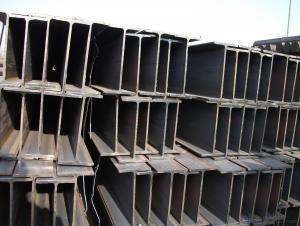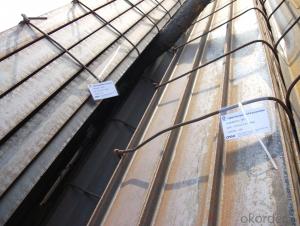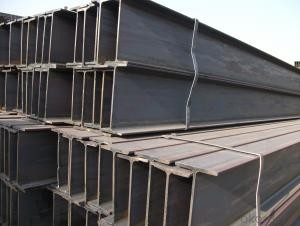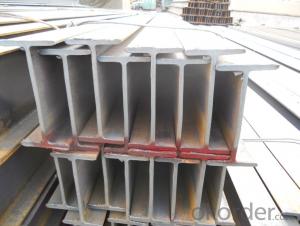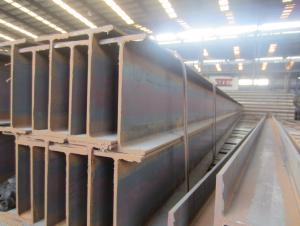H Type Bar Hot Rolled Steel Heb Bar H Iron Beam Steel
- Loading Port:
- Tianjin
- Payment Terms:
- TT or LC
- Min Order Qty:
- 27 m.t.
- Supply Capability:
- 20000 m.t./month
OKorder Service Pledge
OKorder Financial Service
You Might Also Like
Specifications
Hot Rolled Steel Heb Bar
1.Better price
2.Professional service
3.Mass stock
4.Fast delivery
H beam is widely used in various building structure and engineering structure:
a).used for the plant, high-rise building construction
b).used for the bridge, shipment building
c).used for lifting and transportation machinery, equipment manufacturing base building
d).used for the support, foundation pile manufacturing
Detailed description of H beam:
| Shape | H |
| Szie | 100x50x5x7---900x300x15x28,or as per your request |
| Standard (steel H beam) | GB/T3094-2000 GB/T6728-2002 ASTM A500 JIS G 3466 DIN EN 10210 |
| Material | Q195,Q235,Q345, 20#,45#,S235,S355,St37,St52,SS400 |
| Technique | Hot rolled,Cold Rolled,ERW,High-frequency welded,Extruded |
| Certification | CO;FE; MTC |
| Surface | Galvanized,Paint,Oil |
| Length | 5.8m (load into 20' container) 6m 11.8m(load into 40 container) 12m or according to customer's request |
| Uasge | Construction;Building;Ship building; |
| Port of Shipment | Shanghai;Tianjin |
| Main Market | Southeast Aisa;Middle East;Afica |
| Package | Seaworthy packing or according to your request |
| Productitity | 5000 ton per month;20000 ton per season |
| Pls noted | In order to make best quotation, Please kindly indicate length, width, thickness and the standard, material you required |
FAQ:
Q1: Why buy Materials & Equipment from OKorder.com?
A1: All products offered byOKorder.com are carefully selected from China's most reliable manufacturing enterprises. Through its ISO certifications, OKorder.com adheres to the highest standards and a commitment to supply chain safety and customer satisfaction.
Q2: How do we guarantee the quality of our products?
A2: We have established an advanced quality management system which conducts strict quality tests at every step, from raw materials to the final product. At the same time, we provide extensive follow-up service assurances as required.
Q3: How soon can we receive the product after purchase?
A3: Within three days of placing an order, we will begin production. The specific shipping date is dependent upon international and government factors, but is typically 7 to 10 workdays.
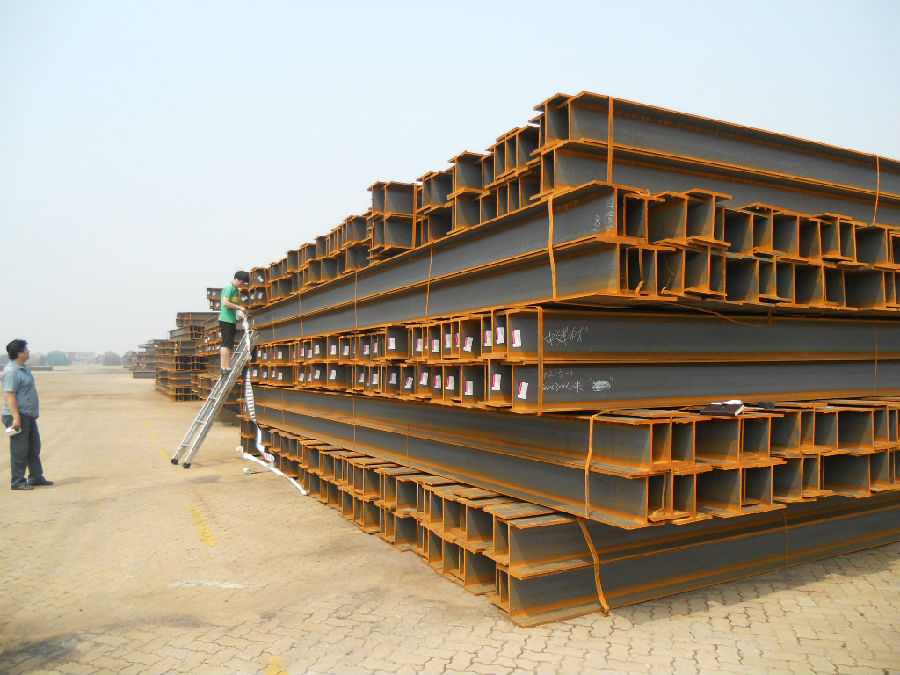
- Q:Are steel H-beams resistant to pests like termites?
- Steel H-beams possess a high level of resistance against pests such as termites. In contrast to wooden beams, which are prone to termite infestations, steel H-beams do not serve as a food source for termites nor create a suitable environment for their thriving. Termites primarily feed on cellulose, a substance present in wood. However, as steel is not composed of organic material, termites are not attracted to it. Furthermore, steel H-beams are impervious to moisture damage and decay, which are other factors that can attract and sustain termite colonies. Consequently, incorporating steel H-beams in construction markedly diminishes the risk of termite infestation and potential harm to the structure.
- Q:How do steel H-beams contribute to the overall sustainability of a structure?
- Steel H-beams contribute to the overall sustainability of a structure in several ways. Firstly, steel is a highly durable material that can withstand extreme weather conditions, seismic activities, and fire, which ensures the longevity and safety of the structure. This durability reduces the need for frequent repairs or replacements, minimizing the consumption of resources and waste generation. Additionally, steel H-beams are lightweight compared to other building materials like concrete or wood, which reduces the overall weight of the structure. This lightweight characteristic allows for more efficient transportation and construction processes, leading to reduced energy consumption and carbon emissions during construction. Moreover, steel H-beams are highly recyclable, making them a sustainable choice. At the end of a building's life cycle, these beams can be easily dismantled and recycled into new steel products without losing their inherent properties. Recycling steel reduces the demand for virgin materials, conserves energy, and reduces greenhouse gas emissions associated with the production of new steel. Furthermore, steel H-beams offer design flexibility, allowing architects and engineers to create innovative and efficient structures. Their versatility enables the optimization of material usage, reducing waste and maximizing the use of resources. This adaptability also facilitates the future adaptability of the structure, allowing for modifications or expansions without extensive demolition or reconstruction. Lastly, steel H-beams have a high strength-to-weight ratio, meaning they can support larger loads with less material. This efficiency in material usage reduces the overall environmental impact of the structure, as less steel is required to achieve the same structural integrity. Therefore, the use of steel H-beams in construction contributes to the conservation of resources and minimizes the carbon footprint of the building. In conclusion, steel H-beams contribute to the overall sustainability of a structure through their durability, lightweight nature, recyclability, design flexibility, and efficient material usage. By choosing steel H-beams, we can create structures that are not only safe and long-lasting but also environmentally friendly, conserving resources and reducing the carbon footprint of the construction industry.
- Q:How do steel H-beams perform in high-wind areas?
- Steel H-beams perform well in high-wind areas due to their inherent strength and rigidity. The structural design of H-beams allows them to resist bending and twisting forces, making them highly suitable for withstanding the intense loads generated by strong winds. These beams have a high load-bearing capacity and can effectively distribute the wind load along their length, which helps prevent structural failure. The shape of the H-beam, with its wide flanges and thick web, provides additional stability against wind forces. The flanges act as wings, creating a larger surface area that helps reduce the wind pressure on the beam. This design feature minimizes the risk of the beam being pushed or bent by the wind. Furthermore, steel is a strong and durable material that exhibits excellent resistance to weathering and corrosion. This makes steel H-beams particularly well-suited for high-wind areas, where exposure to harsh weather conditions, such as saltwater or heavy rain, is common. To ensure optimal performance in high-wind areas, it is crucial to consider the specific design requirements and wind loads that a structure may experience. Engineers use various methods, such as wind tunnel testing and computational fluid dynamics, to accurately predict the wind forces and select appropriate H-beam sizes and configurations. Additionally, proper installation and anchoring techniques are essential to ensure the H-beams remain securely in place during severe weather events. In summary, steel H-beams are designed to perform exceptionally well in high-wind areas. Their structural properties, such as strength, rigidity, and resistance to bending, make them highly reliable for withstanding the forces generated by strong winds. When properly engineered and installed, steel H-beams provide a safe and durable solution for structures in wind-prone regions.
- Q:Can Steel H-Beams be used in roof or ceiling construction?
- Yes, Steel H-Beams can be used in roof or ceiling construction. Steel H-Beams are commonly used in structural applications, including roof and ceiling construction, due to their strength and durability. They provide excellent support and load-bearing capacity, making them ideal for spanning large distances and supporting heavy loads. Additionally, steel H-Beams offer flexibility in design and allow for greater open spaces without the need for excessive columns or supports. Overall, steel H-Beams are a popular choice in roof and ceiling construction due to their structural properties and versatility.
- Q:How do you calculate the moment of inertia for steel H-beams?
- To calculate the moment of inertia for steel H-beams, you need to determine the dimensions and properties of the beam. The moment of inertia can be calculated using the formula: I = (b * h^3)/12 + 2 * (A * d^2), where b is the width of the flange, h is the height of the flange, A is the area of the web, and d is the distance between the centroid of the flange and the centroid of the web. By plugging in these values, you can calculate the moment of inertia for the steel H-beam.
- Q:How do steel H-beams distribute load?
- Steel H-beams distribute load by transferring it evenly across the beam's flanges, which are the horizontal components, and the web, which is the vertical component. This design allows the beam to withstand and distribute heavy loads without bending or buckling under pressure.
- Q:Are steel H-beams suitable for structures with irregular shapes?
- Steel H-beams are commonly used in buildings and bridges for their strength and versatility, but their suitability for structures with irregular shapes depends on design requirements and constraints. In general, steel H-beams are a suitable choice for structures with irregular shapes due to their high structural integrity and load-bearing capacity. They can be used to create complex frameworks and support systems that can accommodate various shapes and configurations. Steel's flexibility allows for customization and adaptation to different architectural designs. However, designing and constructing structures with irregular shapes requires careful planning and engineering. The irregular shape may necessitate additional support or reinforcement to ensure structural stability. This can be achieved by combining H-beams with other structural elements, such as braces or trusses, to effectively distribute the load. To assess the suitability of steel H-beams for a specific irregular-shaped structure, it is important to consult professional engineers and architects specialized in structural design. Their expertise can provide valuable insights and calculations to ensure that the H-beams are appropriately sized and positioned to meet the structural requirements and maintain the overall structure's safety. In conclusion, steel H-beams can be suitable for structures with irregular shapes, but their application requires careful consideration of specific design constraints and the expertise of professionals in the field of structural engineering.
- Q:What are the different methods of protecting steel H-beams from corrosion?
- There are multiple options available for safeguarding steel H-beams against corrosion. 1. Galvanization provides a protective layer of zinc coating on the steel beams. This zinc layer acts sacrificially, corroding first to shield the steel from oxidation. Galvanized steel beams exhibit exceptional resistance to corrosion and can endure harsh environments. 2. Another approach is to apply a protective paint coating to steel H-beams. This creates a physical barrier between the steel and the surroundings, preventing moisture and oxygen from reaching the metal surface. Regular maintenance and periodic repainting may be necessary for long-term protection. 3. Epoxy coatings are commonly employed in industrial settings to safeguard steel beams from corrosion. These coatings create a robust and durable barrier that withstands moisture, chemicals, and UV radiation. Various thicknesses of epoxy coatings can be utilized to meet specific requirements. 4. Powder coating involves the application of dry powder to the steel beams, which is then heated and fused to form a protective layer. This method provides a durable, chip-resistant coating that delivers excellent corrosion protection. Powder coatings are available in a diverse range of colors and finishes. 5. Cathodic protection entails connecting the steel H-beams to a sacrificial anode, like zinc or magnesium, through an electrical circuit. By sacrificing themselves, the anodes corrode instead of the steel beams, effectively preserving them from oxidation. Cathodic protection finds frequent usage in marine environments or structures buried in soil. 6. Vapor corrosion inhibitors (VCI) incorporate special packaging materials that release protective vapors. These vapors form a molecular layer on the steel surface, thwarting corrosion. VCI methods are commonly employed for protecting steel H-beams during shipping and storage. It is crucial to consider the specific application, environmental conditions, and budgetary constraints when selecting the most appropriate method for safeguarding steel H-beams against corrosion.
- Q:What's the difference between hot rolled H steel and welded H? Is it the same weight?
- The product has high precision and good surface quality. Because of the high precision and good surface quality of the steel plate, the accuracy of the H after welding is high and the surface quality is good. (used for welding H steel plate) the thickness deviation is generally a few hundredths of a millimeter to zero a few millimeters, and the thickness deviation of hot rolled H steel is a few tenths of mm to 1 mm, is nearly 10 times.
- Q:What are the different types of steel H-beams available?
- There are several different types of steel H-beams available, including standard H-beams, wide flange beams, and lightweight beams. Standard H-beams have a wider flange and are commonly used in construction and structural applications. Wide flange beams have a wider flange and are typically used for larger structural projects. Lightweight beams are designed to be lighter in weight, making them suitable for applications where weight is a concern, such as in automotive or aerospace industries.
1. Manufacturer Overview |
|
|---|---|
| Location | |
| Year Established | |
| Annual Output Value | |
| Main Markets | |
| Company Certifications | |
2. Manufacturer Certificates |
|
|---|---|
| a) Certification Name | |
| Range | |
| Reference | |
| Validity Period | |
3. Manufacturer Capability |
|
|---|---|
| a)Trade Capacity | |
| Nearest Port | |
| Export Percentage | |
| No.of Employees in Trade Department | |
| Language Spoken: | |
| b)Factory Information | |
| Factory Size: | |
| No. of Production Lines | |
| Contract Manufacturing | |
| Product Price Range | |
Send your message to us
H Type Bar Hot Rolled Steel Heb Bar H Iron Beam Steel
- Loading Port:
- Tianjin
- Payment Terms:
- TT or LC
- Min Order Qty:
- 27 m.t.
- Supply Capability:
- 20000 m.t./month
OKorder Service Pledge
OKorder Financial Service
Similar products
New products
Hot products
Hot Searches
Related keywords
